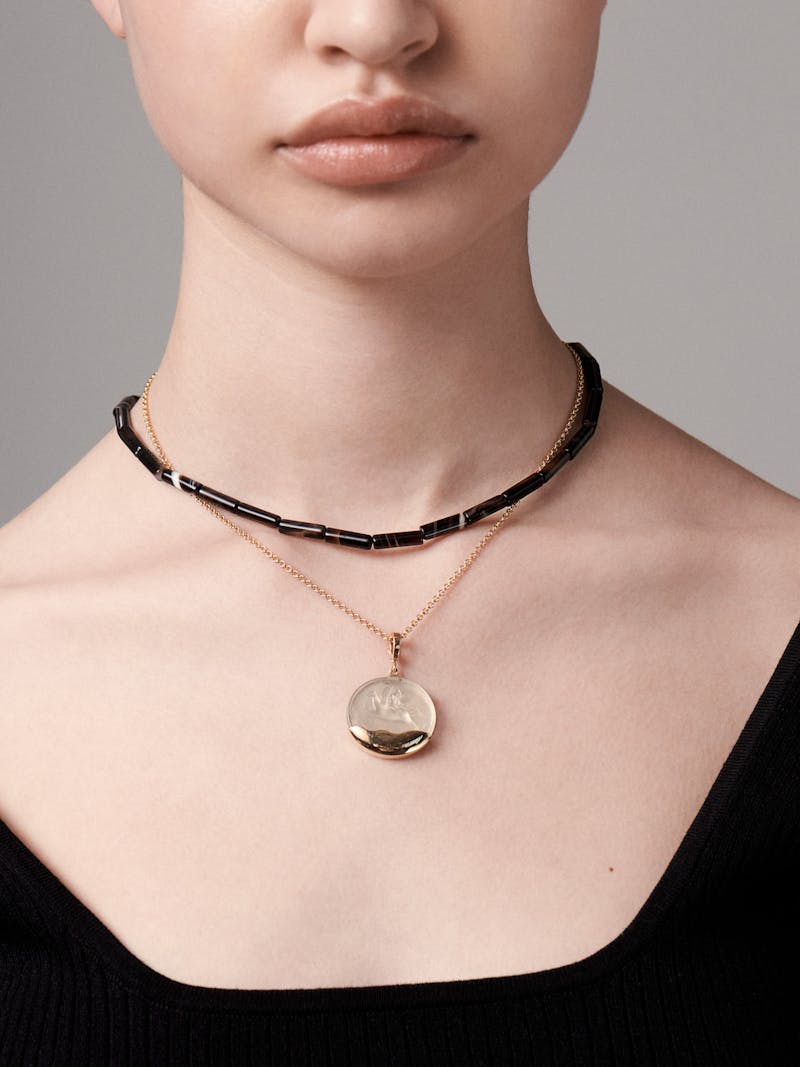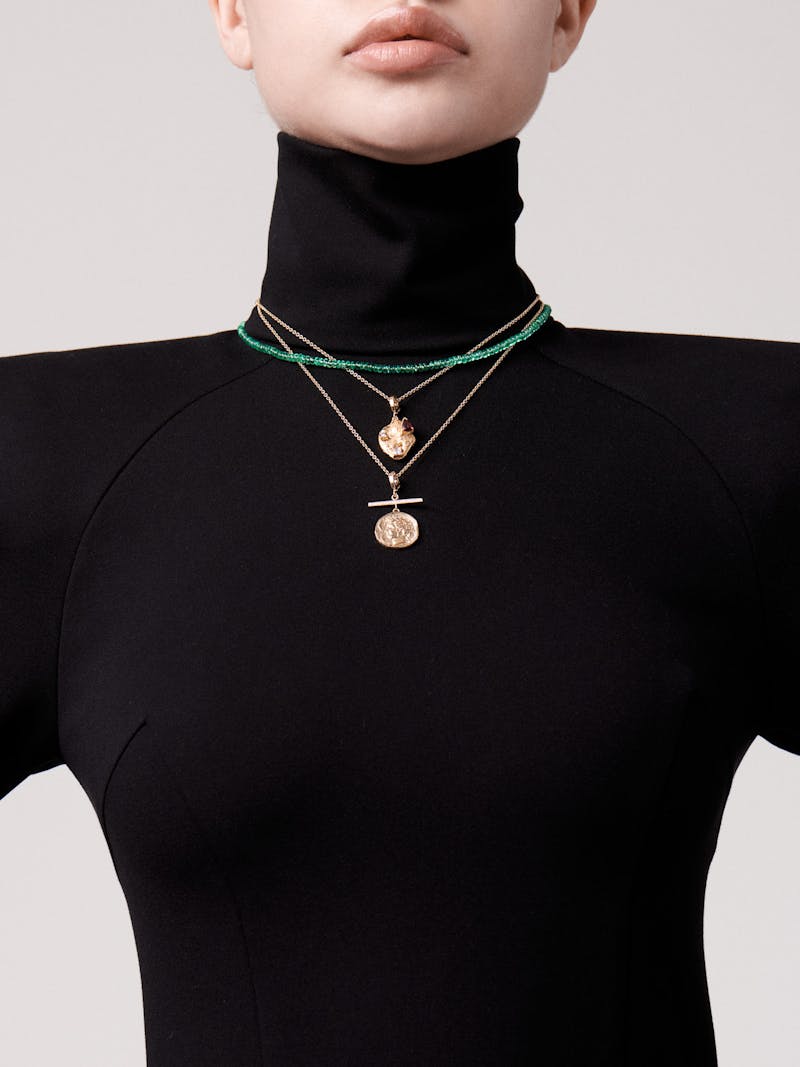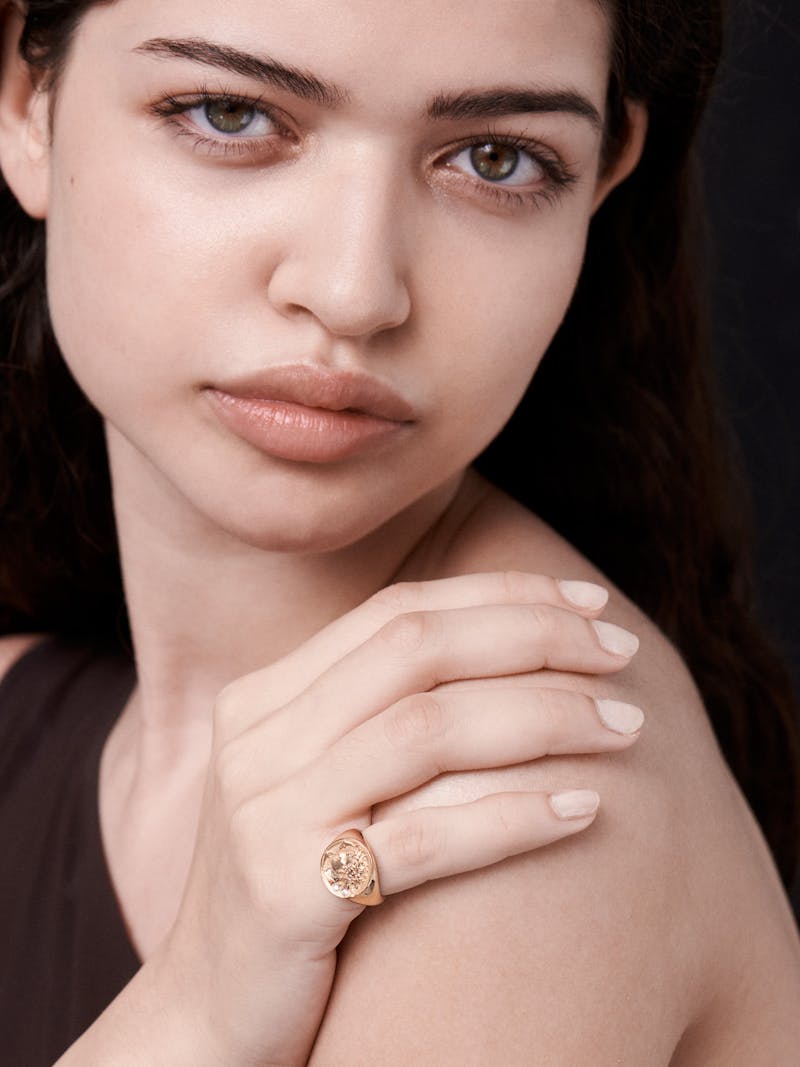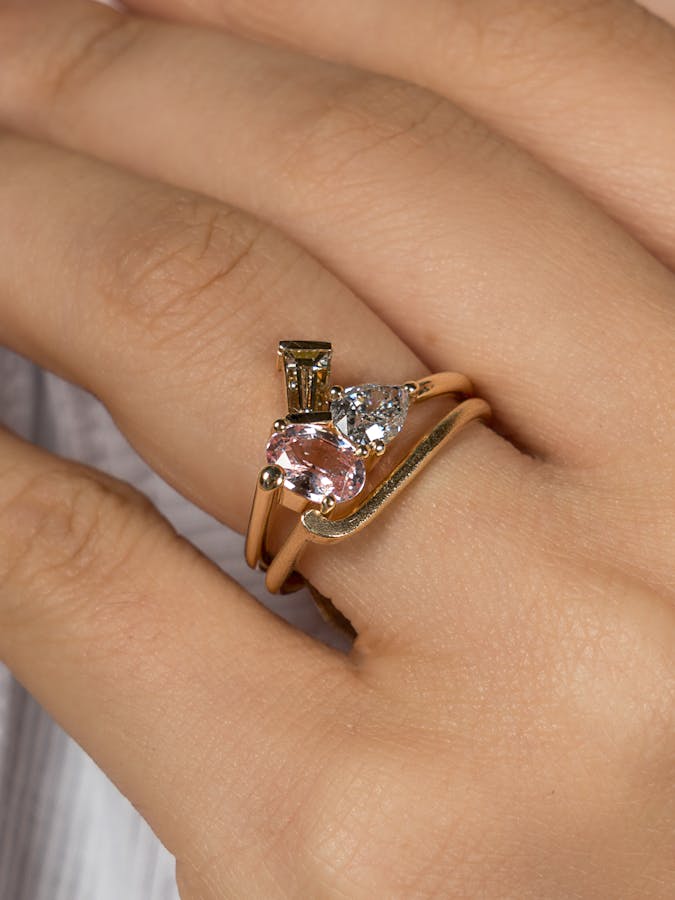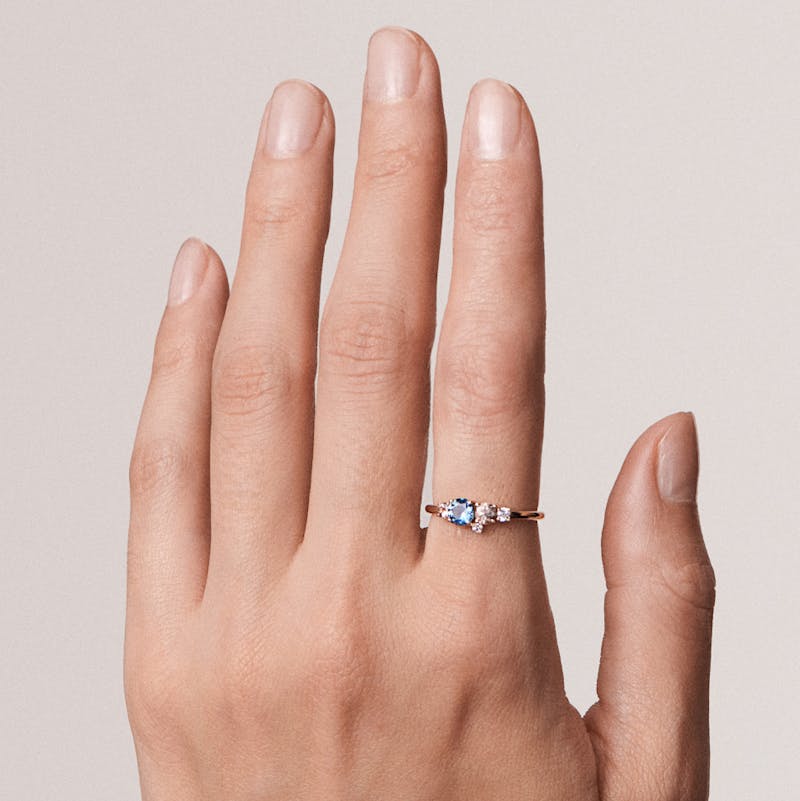Baylee Ann Zwart
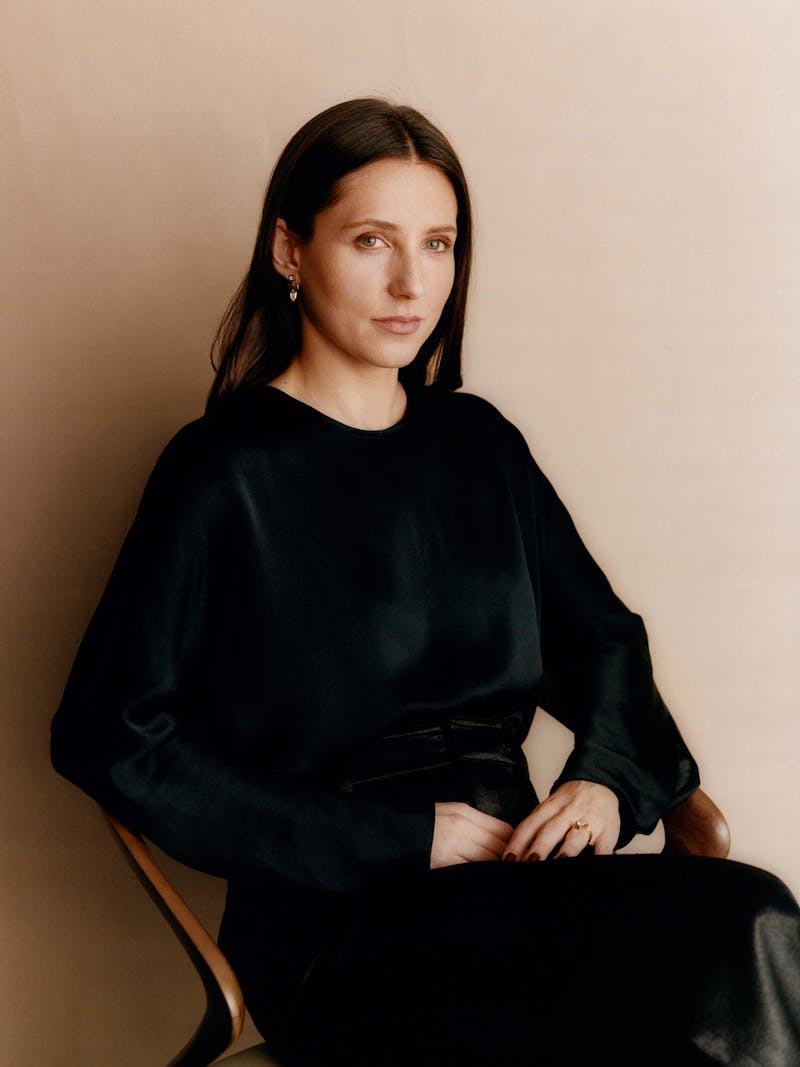
Imagination and connection take centre stage in ĀZLEE's refreshingly modern and meaningful creations
ĀZLEE is a combination of designer Baylee Ann Zwart’s middle, last and first names. Based in Los Angeles, every piece is made locally by master craftsmen, with Baylee overseeing the entire process. Even though it wasn’t always in the cards for Baylee to do fine jewellery, she fell in love with the craft while studying the art of jewellery metal working on the shores of Lake Atitlan in Guatemala.
Made of 18k gold and platinum and influenced by French Art Deco and Ancient civilisations, ĀZLEE is a refreshingly modern brand creating effortlessly wearable and interesting pieces for the individual who finds meaning and connection in the jewellery they wear.
How did you end up in jewellery, because I know that’s not where you started?
It came out of left field for me. I had worked at fashion magazines and I was really interested in photography and I thought that was my path—it was my creative outlet at the time. But I realised at some point that I couldn’t see my future in it. I was really interested in sustainable fashion, so I found an organization in Guatemala that did fair trade accessories with women artisans. They very much had a presence in the fashion space, but at the same time it was non-profit and great work they were doing. During my six months in Guatemala, I happened to end up in a spot with a lot of metalworking. I found a stone and I asked one of the artisans to make me a ring with it, but he asked me if I wanted to make it myself. It hadn’t even occurred to me that it was a possibility, but I decided to go for it. I made that first ring and just fell madly in love with metalworking and the whole process. Being able to wear and enjoy something every single day was just magical to me. I was hooked. I spent every weekend while I was there, shadowing him for eight hours at a time to learn everything I could. That was my intro to it.
Very cool. I know that now you work with different craftsmen, right? You have a team, locally?
We do everything locally. I realised pretty quickly that when it came to the level of craftsmanship I wanted, I wasn’t going to be able to do it myself. It’s been incredible because we’ve found really amazing people who specialise in every part of the process. The company is six years old now, but it was a couple of years in the making before that, so I’ve been working with them for about eight years now. They know the product in and out, and since it’s all local I am still so hands-on. I choose every measurement, every millimetre, I determine every setting, and I approve it every step of the way.
Maybe we could talk a bit about your aesthetics, because I think your entire universe is so distinct from everything else that’s out there? The combination of things is so unique.
Starting out, I didn’t have any formal design training, but I always designed very linear lines and interesting shapes. I found an enamel artist our second season, who was local here, so I’ve always been using enamel. I think for those reasons I kind of innately designed in a way similar to the Art Deco era. I actually didn’t know much about that era, but I’ve always had people telling me that there’s really this nod to the Art Deco era in all of my work. We use rare cut diamonds, which is also signature to that era. Mostly the European Art Deco though, which had a more restrained approach to shape, proportion and scale, and once I dove into that, I felt so connected to it and rooted in it. It’s cool because as I’ve learned more, I’ve obviously incorporated more of those aspects into our work, so in a way, that part just happened instinctively. The other part, you could say, is due to my fascination with ancient civilisations. Essentially, my work is an extension of all the things I am most passionate about. Why not bring all of those things in? It gives me a reason to spend time in those areas. I started diving into ancient cultures and symbols that have been used through history. That’s what landed us on coins. My favourite thing about it was that it took the brand in a very romantic direction. Merging the sophistication of the architectural and clean lines with the romance of ancient cultures is what makes it interesting to me.
"This new category of fine jewellery that feels really dynamic, meaningful and relevant, is just so incredible. And I am so grateful that I landed in this time, because it still feels kind of like the beginning of that."
It is really beautiful. And now that we are talking about passions, maybe we can talk about your relationship with the ocean?
I love the ocean. Someone asked me recently, “what is it about the ocean?” It is hard for me to explain, because it’s something deep within. It’s been there for me my whole life. I just figured when I started the company, why not combine two things that interest me? I had come from non-profit backgrounds and then I was at Tom’s shoes doing design and development, and they were the leaders in for profit business combined with non-profit giving. When I started out, I really wanted to touch upon different ocean related non-profits that are leaders in their area. From the very beginning, we just started doing a percentage of sales going towards whatever partner we worked with that year. And we’ve actually extended the partnership to two years, so that we can have even more impact with these organizations.
I think this takes us into all your thoughts on values and sustainability, because it is not only about giving to these organizations, but also much more than that?
Yes! I really don’t believe anyone can claim they have a sustainable company because there are so many aspects to it that you can’t possibly be touching on every single one. We have to prioritise what we focus on. Local production is hugely important to me, and we do everything out of LA so that I can oversee everything myself first-hand. I want to support our local economy and local artisans. I love how we are in a product category that still has manufacturing in the United States, because so much manufacturing has left here. Whether there’s no longer an infrastructure for it or the consumer is no longer willing to pay for local production, we luckily do not fall into either of these. It is such a generational craft and art that I find it beautiful to continue to support that locally. We focus on local production and of course looking into our supply chain, understanding where our metals and stones are coming from. I’ve learned a lot about fair-trade gold versus recycled gold, and I believe there’s no reason we should be mining if there’s enough supply already in the marketplace, which there is for us to be consistently using 100 percent recycled gold.
And your stones?
When it comes to our stones, we are being mindful of our suppliers and how direct they are to the mining process. The Kimberley process has helped a lot with ethically sourcing diamonds. Looking at the product end, we are always introducing more vintage and post-consumer stones, which I think is awesome because it requires no new mining. The reason why I ended up in fine jewellery versus costume jewellery was that I realised how costume jewellery is a disposable product, which is the last thing I wanted to put out into this world. It was so important to me to create a product that lasts a long time and always retains its value. One of the most beautiful things is that even when polishers are polishing, they collect the dust that comes off the gold and you use that to melt down again. Inherently, nothing is wasted in fine jewellery. That’s a really cool sustainability aspect in itself.
It is indeed, and this idea that you can pass it on, through generations. Do you remember the first piece of jewellery you were gifted or that you inherited?
My grandmother gave me this tiny little diamond necklace on my 16th birthday, and it was so special to me. I had never had a diamond before, my family weren’t big jewellery people, and my grandparents were not particularly wealthy by any means. So, to have her pass down something like that was a very big deal. I thought it was the coolest thing ever, and I still think it’s the coolest thing ever. The simplest piece of jewellery, a tiny little diamond on a chain, but something that you will have forever. Even if you reset it, it will still have the energy of that diamond from my family.

I guess that sentimental value is what jewellery is also about?
Exactly, and it is still there even if you reset the piece and totally reimagine it—you still feel so connected to that sentimental value.
Definitely. I had written down what the role is of jewellery today, but I guess I was more thinking about how we buy jewellery for ourselves, because I have this feeling that women are buying more for themselves now?
Before I started, not even that long ago, there wasn’t even this category of modern fine jewellery. There was costume jewellery and fine jewellery, very traditional, and oftentimes very conservative. So, this new category of fine jewellery that feels really dynamic, meaningful and relevant, is just so incredible. And I am so grateful that I landed in this time, because it still feels kind of like the beginning of that. And I think that lends itself to women being able to identify with and buy for themselves versus someone else picking pieces out for them, and basing what they are choosing on just specs, like the specs of stones. I feel like there wasn’t a ton of imagination and connection to it before. I think it is super empowering that women are buying for themselves and I think this new category really lends itself to that, which is so exciting to create jewellery for women to connect with.
Do you have a favourite piece of jewellery yourself that you own?
It’s so hard. But my engagement ring is the shield diamond ring, and it was the first unusual cut that we did. I had no intention of going into custom, but that kind of launched our custom business. That is so special to me and has become such a signature to us, we create so many of them now. I went through a 1.5-year long process to find the diamond and it was such an adventure of learning and really understanding the ins and outs of diamonds and working with different collectors to find this one-of-a-kind, unusual shape. I feel like that’s probably my most treasured possession.
Now that you mention custom pieces, maybe we can talk about your collections too? Because on Finematter we are going to have pieces from your collections. How do you build a collection and how do the ideas for the collections come up?
In the beginning, our collections were heavily based around a totally new theme or concept every season. Now, it is a more comfortable place because every season feels like an evolution to something that started years ago that I am still passionate about. I get to build on and reimagine concepts and creating them in whole new ways. Our coins have worked so well, and then thinking about how to do something new in that vein, hitting a different look or using a new technique. Our amulets came out of that. They pull from the same ancient references and have similar symbolism, but they look totally different. I also love materials and finding unusual materials that aren’t used very often, but that are still in the colour palette of our collections. I recently found the Venetian glass coins from a man in Italy, who casts them, and then we do all of the setting here. It works perfectly with everything else we are doing, but it is such an unusual technique and material to work with. Last season we introduced the staircase collection. It visually feels like a symbolic representation of the brand: ancient ascending multi-layered architecture combined with Art Deco diamonds in the centre. It felt totally right. We really dove into that this season and expanded on it. I like to dip my toes in things and see how the market reacts, and then if it’s good, go all-in the following season to really build it out. It is kind of scary to try new things, but I have so much fun then diving in and really making it a thing.
I like the idea of trying it out a little bit to see if it works. I guess it also means now that we talked so much about sustainability, it should also be something that people want.
That’s my feeling too. We never end up with stock that didn’t work, because I am very conservative in that way in designing. It is one piece with a singular concept, and then we see if there’s traction around that before we just go all in. I think that has lent itself very well to ideas on sustainability.
